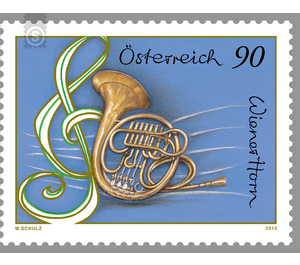Musical instruments - Austria / II. Republic of Austria 2013 - 90 Euro Cent
Theme: Art & Culture
| Country | Austria / II. Republic of Austria |
| Issue Date | 2013 |
| Face Value | 90.00 |
| Edition Issued | 250,000 |
| Printing Type | offset |
| Stamp Type | Commemorative |
| Item Type | Stamp |
| Chronological Issue Number | 2399 |
| Chronological Chapter | OOS-OE2 |
| SID | 546233 |
| In 60 Wishlists | |
The Wiener Horn, the new value from the attractive series "Musical Instruments", is known in the world of music for its particularly colorful sound. In today's orchestral practice, however, it has become a rarity, only a few ensembles - such as the Vienna Philharmonic - still use the Vienna Horn. It is considered extremely difficult to play because it is less accurate in terms of sound production than other horns and the musician demands a high level of craftsmanship. The instrument maker Leopold Uhlmann (1806 to 1878) entered the history of music as the "father of the Viennese horn"; Around 1830 he designed the characteristic pump valves, which at that time were also called "lancing valves". As a simple F-horn, the Wiener Horn has a shorter scale than the double horn that is in common use throughout the world. It has more partials and thus generally sounds brighter - this undoubtedly characterizes the specific "Viennese sound style". The tube length at the Wiener Horn from the mouthpiece to the funnel end is an incredible 3.7 meters. Due to the special position of the valves, the mechanism of the double pump valve promotes soft bonds in legato-played tones, so that the notes flow smoothly into one another. The sonorities of the Viennese Horn result, as comparative studies of Prof. Gregor Widholm, the director of the Institute for Viennese Sound Style, have shown, from the special design: The narrow scale promotes the teilton-rich sound, the tube length affects the energy requirement, the accuracy and indirectly also the sound. Due to the higher energy demand places with many staccato notes claim a player of the Vienna Horn in a particularly high degree. In the higher and higher pitches, the lip tension must be tuned more accurately than with other horns so as not to "land" on a neighboring peak by mistake. The game in these situations therefore requires a bit more concentration and a better "functioning" of fine motor skills at the Vienna Horn. The double pump valves, however, allow flowing sound transitions, but make it difficult to sound clean in fast legato sequences the sounds; These can easily appear "blurry". All in all, the hornist can soften sounds bound to the Vienna horn and change the timbre of the instrument more easily, giving the musician more possibilities for a more sonorous expression. Played "Fortissimo" played Vienna horns also the orchestra sound less strong than double horns


